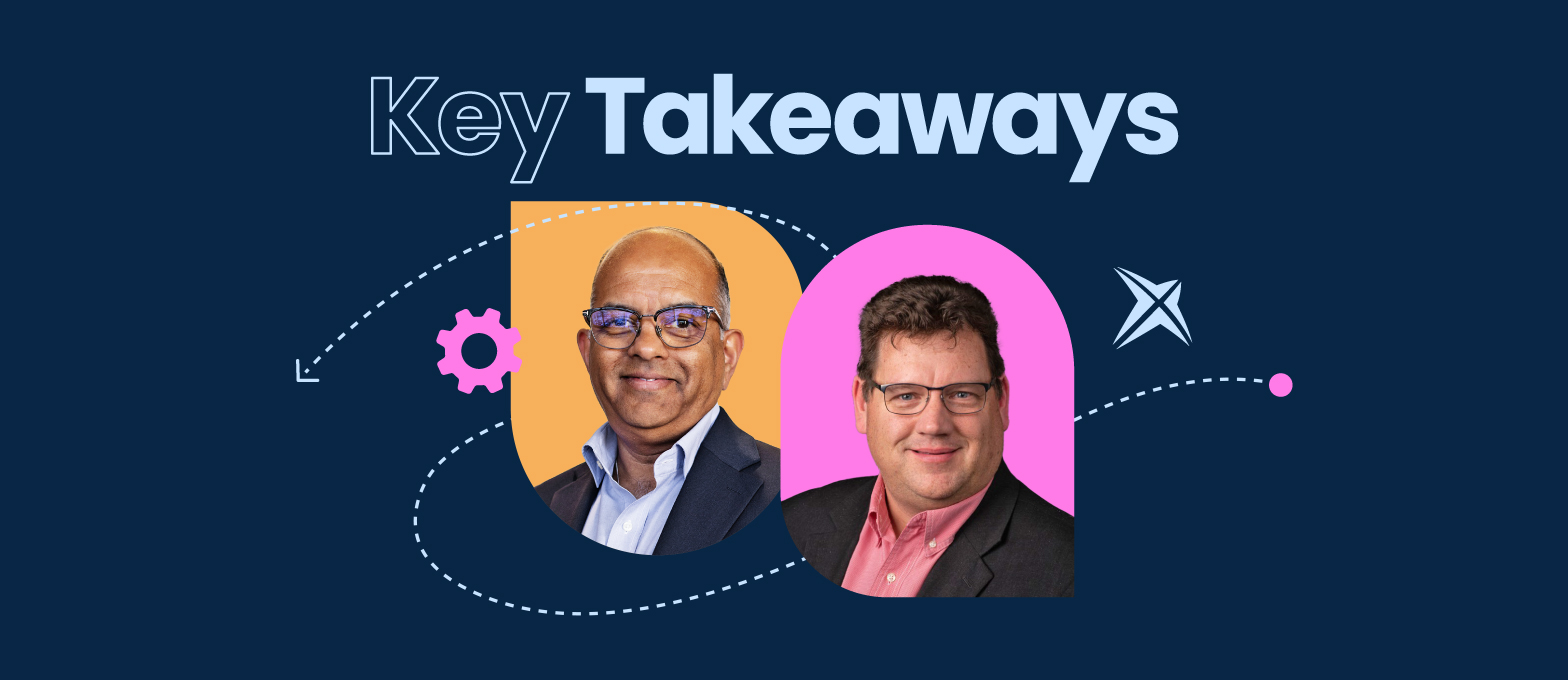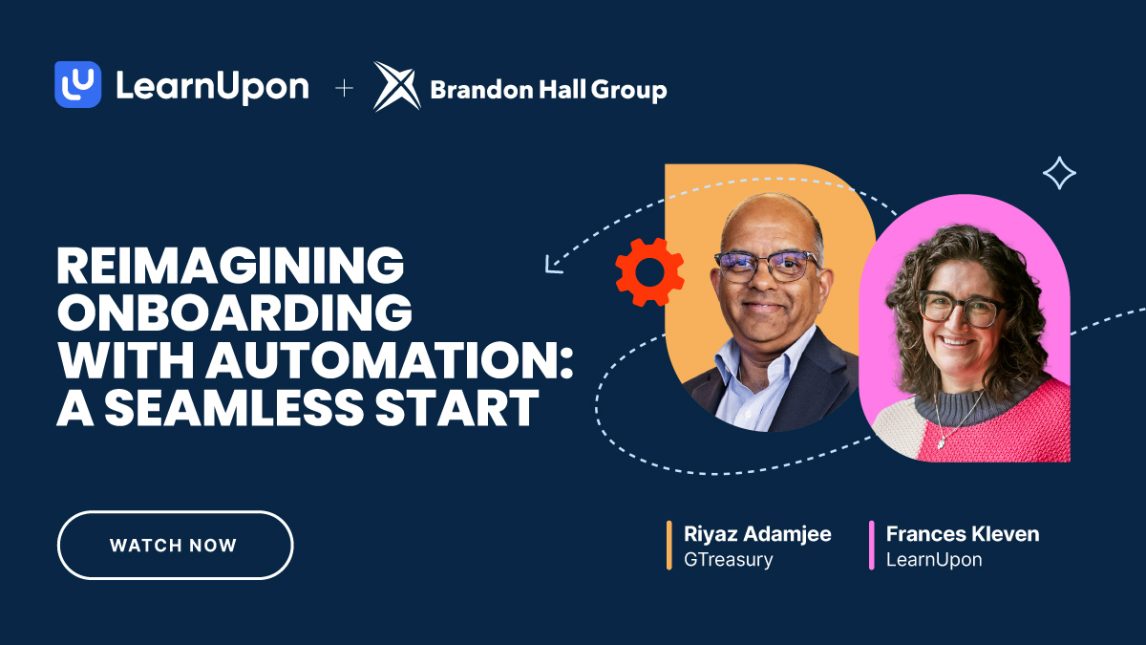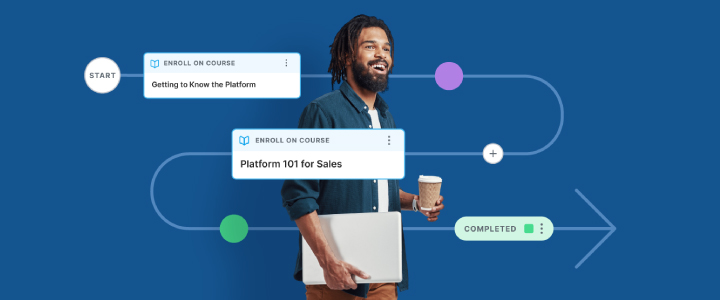
5 min reading time
Reimagining Onboarding with Automation: A Seamless Start: Key Takeaways
Getting your new hires up-to-speed quickly is crucial for any organization. But how can you ensure your onboarding process is not only efficient, but also creates a positive experience while helping new employees contribute sooner?
In a recent webinar with our partners at Brandon Hall Group and GTreasury, we explored the ins and outs of building a stronger onboarding experience. From streamlining administrative tasks to adding a personal touch with automation, we covered it all.
Here’s a recap of the key takeaways shared by experts Riyaz Adamjee (GTreasury’s Vice President, Global Learning Services), Matt Pittman (Brandon Hall Group’s Principal Analyst), and Frances Kleven (LearnUpon’s Director of Enterprise Customer Success), focusing on how effective onboarding builds a stronger people experience right from the start.
How automation can streamline administrative tasks
Automation can significantly simplify the onboarding process by taking care of repetitive and time-consuming tasks. By automating processes like document collection, form submissions, and compliance training, you save time, reduce errors, and allow your HR team to focus more on engaging with new hires rather than getting bogged down in paperwork. With automation running through your onboarding, you can make sure every new hire completes the necessary steps as quickly and consistently as possible.
“We’re currently using AI for developing coursework, designing content, and even video creation. This has significantly cut down the time it takes to create a course, allowing us to get to our backlog faster and focus on more critical tasks.” – Riyaz Adamjee, GTreasury
“The time that we have to onboard employees, and to create onboarding programs for employees themselves to engage in onboarding, is so, so slim. And AI is a conversation to allow us to think about where those answers are of how we address scale, across creating content, in coaching, in onboarding, and in helping people find materials.” – Frances Kleven, LearnUpon.
How to significantly reduce the time and effort needed to onboard new employees
Streamlining the onboarding process can save valuable time and resources for your team. Start by standardizing your curriculum to ensure every new hire receives the same essential training, which reduces the need for repetitive manual instruction. Use technology to automate administrative tasks and organize training materials, making it easier for HR and training staff to manage the process. Break down the training into manageable segments so that new hires can complete it independently while still having access to continuous support and feedback from mentors or peers.
“Initially, our support department onboarding took six to nine months. By standardizing our process and focusing on key learning milestones, we reduced this to three months. This change allowed new employees to become productive much sooner.” – Riyaz Adamjee, GTreasury
How to deliver measurable results and impact to the business
To show the real value of your onboarding program, it’s essential to align your activities with your organization’s goals and keep gathering feedback for constant improvement. This means linking your onboarding processes to specific business objectives, like reducing time to productivity, boosting employee retention, and improving job performance. Regular check-ins and feedback from new hires and their managers help you spot areas for improvement and tweak your strategies accordingly. Sharing these results with key stakeholders not only highlights the impact of your efforts but also helps secure ongoing support.
“What we do is at the beginning of the year, once our corporate goals and objectives are announced, all of our projects are tied to one or more of those, and show the impact that you’re making to those goals and objectives. And that’s a really powerful way of getting visibility and getting the word out on what you’re doing, the impact that you’re making.” – Riyaz Adamjee, GTreasury
How to reduce the time to contribution
Speeding up the time it takes for new hires to start contributing effectively is essential for maintaining momentum and productivity. This involves setting clear expectations, creating structured learning paths, and providing continuous support and feedback. Breaking down training into manageable segments helps new hires to quickly achieve small wins, which boosts their confidence and productivity. Regular check-ins with mentors or managers ensure they stay on track and feel supported throughout their onboarding journey.
“We assigned every new employee a mentor for a certain period. This mentor was there to answer questions and help them get going, which significantly reduced the time needed for new hires to start contributing effectively.” – Riyaz Adamjee, GTreasury
“When they finished a particular learning path, which contained a certain number of courses, we wanted to make sure that the new employee had a purpose. They were able to accomplish something as part of the team, which took the pressure off the rest of the team and helped the new employee feel productive sooner.” – Riyaz Adamjee, GTreasury
Ways to enhance personalization in the onboarding journey
Personalizing the onboarding experience can make new hires feel valued and integrated right from the start. This means tailoring the process to fit individual roles, regions, and even personal preferences. Start by gathering data on your new hires’ backgrounds, interests, and learning styles to create a more customized experience. Use technology, like AI and learning management systems, to deliver personalized training materials and resources. Regular check-ins and feedback sessions can also help adjust the onboarding journey to meet each new hire’s specific needs.
“What AI helps us do is now bring a little bit of personalization for the learner. So depending on what department you’re in, what region you’re based out of, AI can then help give you the information that you’re looking for. And of course, when you’re new to a company, you’re always looking for information. I think AI can bring a lot of benefit to getting the information that I need when I need it.” – Riyaz Adamjee, GTreasury
“We did a survey, a persona survey of our learners, and personalization came up so much when people talked about what they enjoyed about taking online training. It is still such a driver in learning experiences.” – Riyaz Adamjee, GTreasury
Nailing your onboarding process can set the tone for your new hires’ entire journey with your company. By streamlining administrative tasks with automation, you free up your HR team to focus on more meaningful interactions. Standardizing and structuring your onboarding can drastically cut down the time and effort needed, making your new employees feel productive faster.
Personalization adds that extra touch, making new hires feel valued and catered to right from the start. And by tying everything back to your business goals and continuously gathering feedback, you can show the tangible impact of your onboarding efforts.
Want to dive deeper into these strategies? Watch the full webinar for more insights and practical tips from our experts at GTreasury and Brandon Hall Group:




